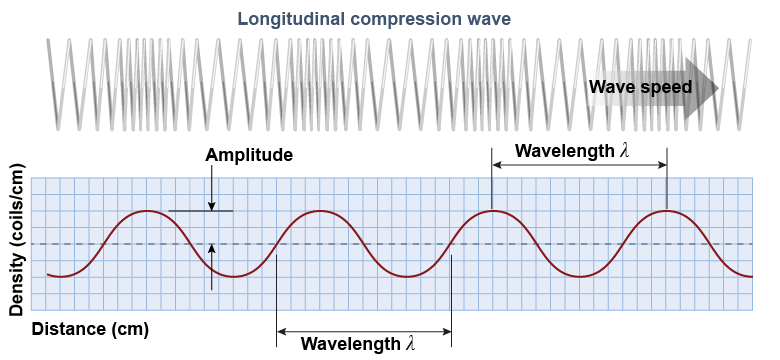|
 If you rapidly move the end of a Slinky® spring forward and backward again, a longitudinal compression wave moves along the spring. A longitudinal wave is either a scalar oscillation or an oscillation of the medium that moves back and forth in the same direction as the wave travels. The compression wave on the Slinky® moves along the length of the slinky. The oscillations are the “bunching” and “stretching” that move along through the spring as the wave travels. Sound is another example of a longitudinal wave.
If you rapidly move the end of a Slinky® spring forward and backward again, a longitudinal compression wave moves along the spring. A longitudinal wave is either a scalar oscillation or an oscillation of the medium that moves back and forth in the same direction as the wave travels. The compression wave on the Slinky® moves along the length of the slinky. The oscillations are the “bunching” and “stretching” that move along through the spring as the wave travels. Sound is another example of a longitudinal wave. 
|

|
The amplitude of the compression wave is the difference between the maximum “bunching” and the average, resting spacing of the spring. The amplitude of any longitudinal wave is the difference between the average and the maximum displacement away from average of the parameter that is oscillating. For the Slinky® spring the oscillation is in the density of coils per centimeter. For a sound wave the oscillation will be of air pressure. The wavelength of a longitudinal wave is the length of one complete cycle of the amplitude oscillation. The graph shows the wavelength as related to the motion of the spring. This is the same as the distance between one maximum compression and the next maximum compression. 
|
The key distinction between transverse waves (such as light, which you will learn about in Chapter 22) and longitudinal waves (such as sound, which you will learn about in Chapter 16) is the relationship between the direction of the oscillation and the direction the wave travels. Oscillations in transverse waves are perpendicular to the direction the wave travels—meaning that they are rotated 90° away from the wave’s direction of motion. Oscillations in longitudinal waves are either parallel to the direction the wave travels—such as the compression wave on the Slinky®—or they are oscillations of a scalar variable, such as pressure. 
|
Is the “wave,” such as would be performed at a sporting event, a transverse or longitudinal wave?
 |
The “wave” is a transverse wave. The oscillation is perpendicular to the movement of the wave; audience members move their arms straight up as the wave moves across the stadium. 
|

